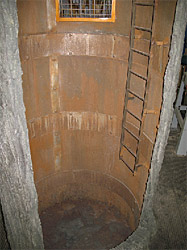See…without being seen
July 26, 2009
Camouflage came about during the First World War when the advent of airplanes made invisibility a necessity. Heavy artillery, helmets, and jackets were camouflaged by painting them to mimic the natural environment. But camouflage was soon recognized as both an offensive and passive tactic.
The French were credited for the first “dummy tree”, a decoy utilized by a number of armies. The idea was simple: identify and sketch a large, strategically-situated tree from where enemy lines could be seen; then, in the special camouflage units’ workshops, artists would create an exact replica using a bark-covered steel cylinder. A ladder would allow soldiers to observe from an elevated position through a small opening. The whole thing looked more like a stage prop than a military tactic until, in the dead of night, the original would be chopped down and quickly replaced by the replica – all without detection.

Short-lived works
The decoys were not meant to last, and very few survived the bombardments. Recreating one for the Camouflage exhibit at the Canadian War Museum would require a call to Geoff Wonnacott, Head of Display Services for the Canadian Museum of Civilization. The ensuing collaboration between the two museums brought historical knowledge together with construction techniques to achieve all the desired components of this exhibition feature.
 In their Laurier Street workshop, Wonnacott and his team analyzed the sketches and photos at their disposal. Their first challenge for the “dummy tree” was to create a model that would be both recognizable to visitors yet faithful to period sketches (trees depicted in the images were mostly ‘plane trees’ that are foreign to Canada). So Wonnacott dug up a latex mould that he had created years earlier from an old dead tree on his property. Applying a sticky acrylic product to netting created strikingly accurate tree bark. And when it was glued to the thick cardboard trunk that had been given a rusted metal look, the effect was extremely realistic – a simpler and more cost-effective version than the bulletproof trunks of the past.
In their Laurier Street workshop, Wonnacott and his team analyzed the sketches and photos at their disposal. Their first challenge for the “dummy tree” was to create a model that would be both recognizable to visitors yet faithful to period sketches (trees depicted in the images were mostly ‘plane trees’ that are foreign to Canada). So Wonnacott dug up a latex mould that he had created years earlier from an old dead tree on his property. Applying a sticky acrylic product to netting created strikingly accurate tree bark. And when it was glued to the thick cardboard trunk that had been given a rusted metal look, the effect was extremely realistic – a simpler and more cost-effective version than the bulletproof trunks of the past.
Claustrophobes, look out
 To give visitors a true idea of what the soldiers posted to these trunks went through, a large opening was made to expose the interior. The real decoys, accessible only through a concealed trench, would typically have been built on a concrete base that would have been buried in the earth.
To give visitors a true idea of what the soldiers posted to these trunks went through, a large opening was made to expose the interior. The real decoys, accessible only through a concealed trench, would typically have been built on a concrete base that would have been buried in the earth.
A tiny ladder leads to the top of the trunk where a peephole allows a view of the enemy camp. An additional peephole was created at a lower height to allow visitors to spy out on the exhibition.
With this “dummy tree”, Geoff Wonnacott and his team have demonstrated the same resourcefulness and creativity as those original ‘camoufleurs’. Now that makes for history that’s accessible to us all.
A tree to see … without being seen.